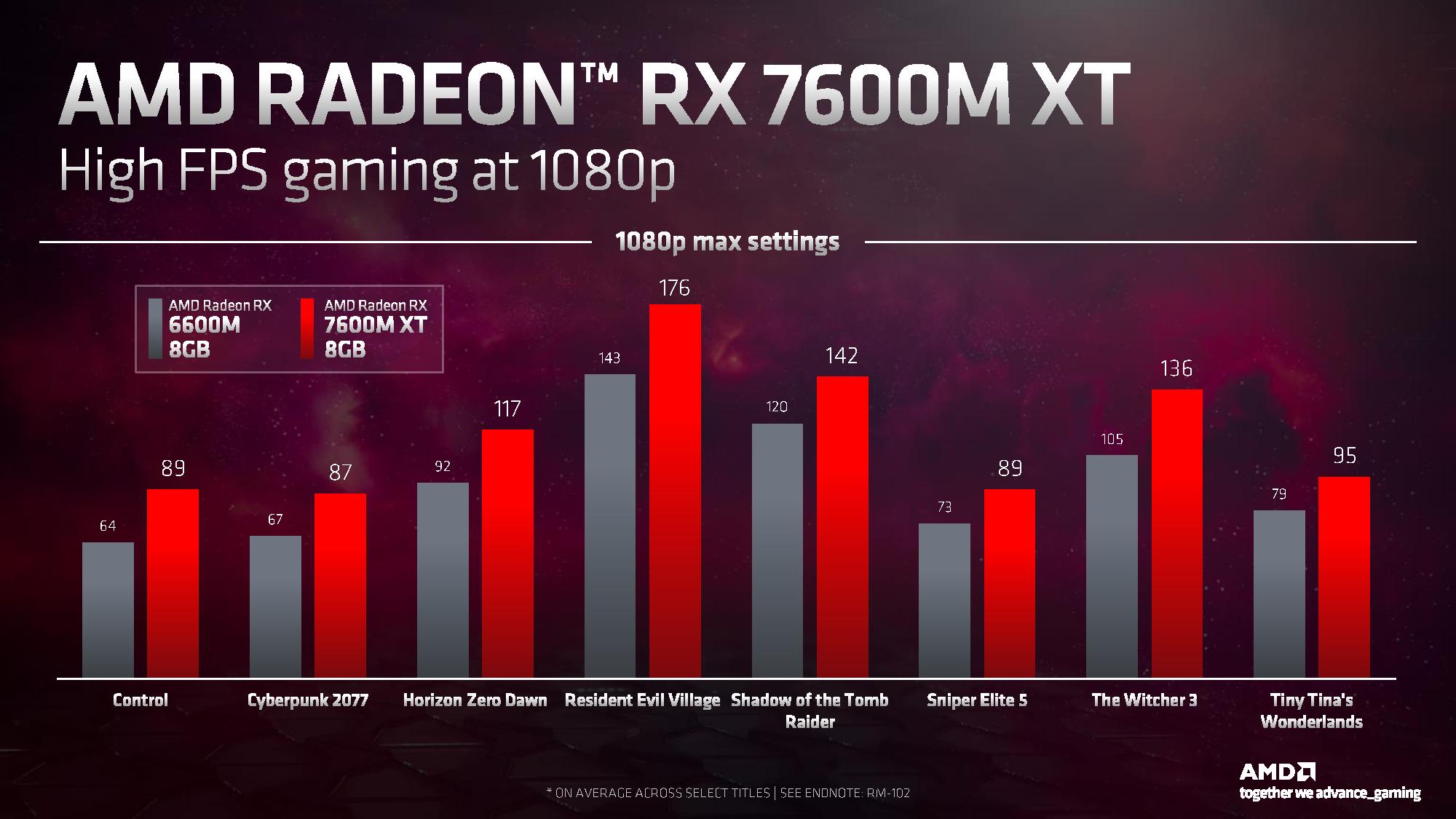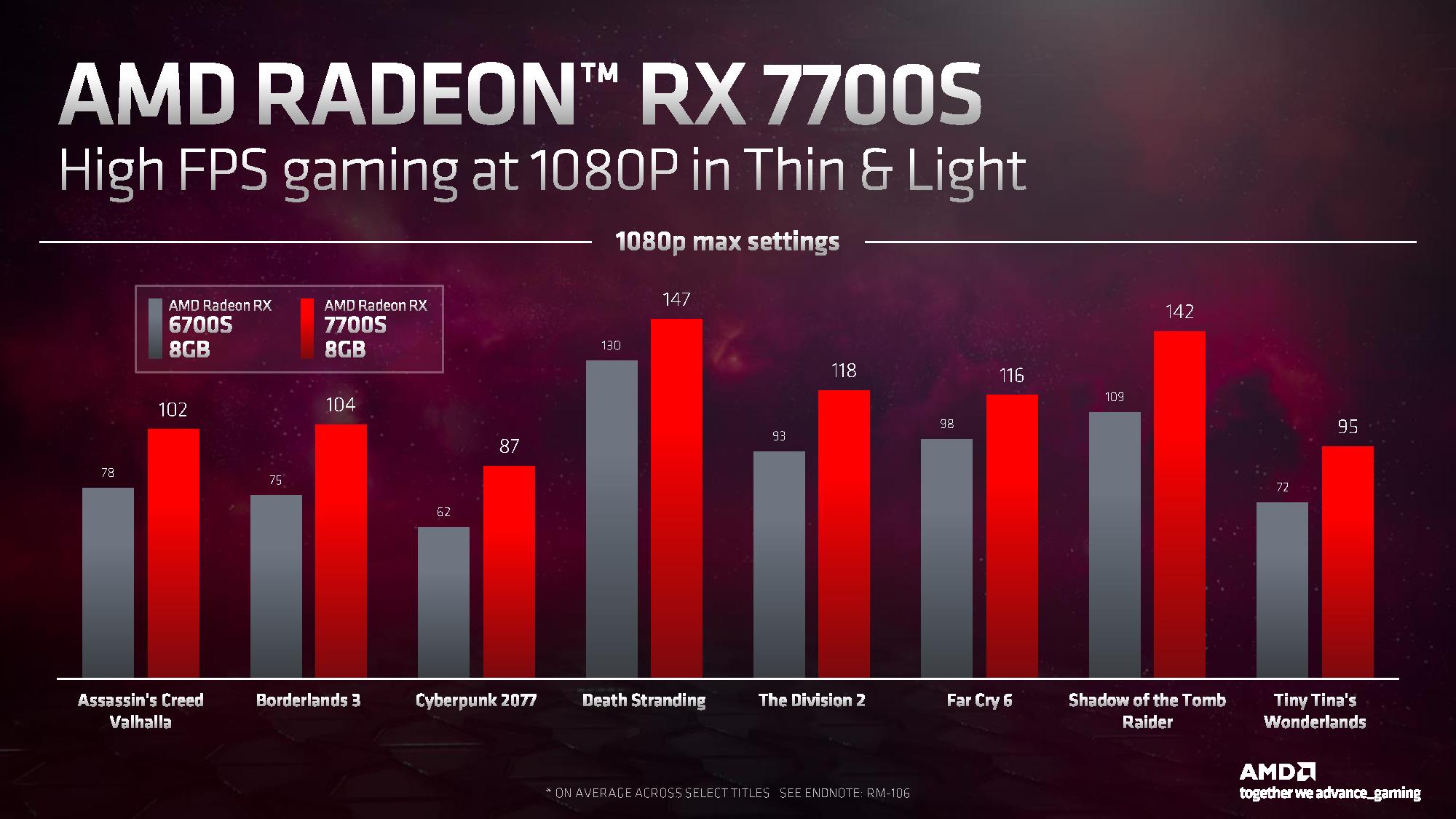AMD has unveiled the company's new Radeon RX 7600M and Radeon RX 7000S graphics card for laptops. The mobile RDNA 3 graphics cards, which power performance gaming and thin and light devices, respectively, will arrive on the market starting in February.
The Radeon RX 7600M and Radeon 7000S series wield unified RDNA 3 compute units with RT and AI accelerators. In addition, they support AV1 encoding and decoding and AMD's new Smart Technologies. On a silicon level, the Radeon RX 7600M and Radeon 7000S series feature a monolithic die that measures 204 mm² and is a product of TSMC's 6nm process node. AMD uses the same silicon across all four mobile graphics cards with disabled compute units when needed. The chipmaker didn't reveal the silicon, but it's likely the Navi 33 die. For comparison, Navi 23 measures 237 mm², so Navi 33 is 14% smaller.
The Radeon RX 7600M XT targets high-framerate gaming laptops at 1080p (1920x1080). It wields 32 compute units, equivalent to 2,048 shader processors. The 32-compute-die configuration is probably the full Navi 33 die since Navi 23 also tops out at 32 compute units. The Radeon RX 7600M XT delivers up to 32 TFLOPs of FP32 performance. The graphics power range without AMD SmartShift for the Radeon RX 7600M is between 75W to 120W.
On the other hand, the Radeon RX 7600M checks in with 28 compute units, just four less than the XT variant. The graphics card offers 28 TFLOPs of FP3 performance, so it's not so far behind the Radeon RX 7600M XT. The lower core count allows the Radeon RX 7600M to play within the 50W to 90W power range.
AMD equips the Radeon RX 7600 series with 8GB of GDDR6 memory, a 128-bit memory interface, and a 32MB Infinity Cache. The capacity of the Infinity Cache has not changed in the transition from Navi 23 to Navi 33. Only the memory speed varies between the two models. The Radeon RX 7600M XT has 18 Gbps memory, whereas the Radeon RX 7600M sticks to 16 Gbps.
It wasn't just about RDNA 3, though. Instead, AMD added three new SKUs to the company's existing RDNA 2 Radeon RX 6000M lineup: the Radeon RX 6550M, Radeon RX 6450M, and Radeon RX 6550S.
| Header Cell - Column 0 | AMD Radeon RX 7600M XT | AMD Radeon RX 7600M | AMD Radeon RX 7700S | AMD Radeon RX 7600S | AMD Radeon RX 6550M | AMD Radeon RX 6450M | AMD RadeonRX 6550S |
|---|---|---|---|---|---|---|---|
| Graphics Power Range without AMD SmartShift | 75W - 120W | 50W - 90W | 75W - 120W | 50W - 75W | 50W - 80W | 25W - 50W | 35W - 50W |
| Architecture | RDNA 3 | RDNA 3 | RDNA 3 | RDNA 3 | RDNA 2 | RDNA 2 | RDNA 2 |
| Compute Units | 32 | 28 | 32 | 28 | 16 | 12 | 16 |
| Shader Processors | 2,048 | 1,792 | 2,048 | 1,792 | 1,024 | 7,68 | 1,024 |
| GDDR6 Memory Size | 8 GB | 8 GB | 8 GB | 8 GB | 4 GB | 4 GB | 4 GB |
The Radeon RX 7000S offerings are almost identical to the Radeon RX 7600M series. The Radeon RX 7700S and RX 7600S have the exact core count and memory configuration. The differentiating factor is the power limit. The Radeon RX 7700S has a power range between 75W to 100W compared to the Radeon RX 7600M XT's 75W to 120W limit. Meanwhile, AMD rates the Radeon RX 7600S for 50W to 75W instead of the 50W to 90W range on the Radeon RX 7600M.
Stay On the Cutting Edge: Get the Tom's Hardware Newsletter
Get Tom's Hardware's best news and in-depth reviews, straight to your inbox.
According to AMD, the Radeon RX 7600M XT is between 18% to 39% faster than the previous Radeon RX 6600M. The chipmaker's results also have the Radeon RX 7600M XT between 7% to 37% ahead of Nvidia's desktop GeForce RTX 3060. On average, it's over 31% faster. Surprisingly, AMD didn't provide any benchmarks for the Radeon RX 7600M, so its performance remains a mystery for now.
The Radeon RX 7700S will also offer a significant upgrade over the Radeon RX 6700S. AMD's tests exhibit improvements that range from 13% up to 40%.



The Radeon RX 7600M and Radeon RX 7000S series will support AMD's Smart Technologies, including SmartShift to balance processor and graphics card power and SmartAccess, allowing the processor to tap into the graphics card's memory. With these Smart Technologies turned on, consumers could expect up to 30% faster transcoding, 60% better battery life in League of Legends, and up to 33% higher FPS in Forza Horizon 5.
AMD has also introduced SmartShift RSR, a technology that combines uses the APU and GPU together to get the best performance for rendering, upscaling and presentation. SmartShift RSR will arrive in 1H 2023.
Other features include AMD FidelityFX Super Resolution 3.0; 230 titles currently support older versions FSR. There's also AMD HYPR-RX to look forward to, a feature that unleashes additional gaming performance with a single click. AMD claims that the technology improves performance and minimizes input lag. AMD HYPR-RX combines Radeon Anti-Lag, Radeon Boost, Radeon Super Resolution, and other technologies into a single package. It'll also arrive in 1H 2023.

Zhiye Liu is a news editor and memory reviewer at Tom’s Hardware. Although he loves everything that’s hardware, he has a soft spot for CPUs, GPUs, and RAM.
-
bit_user So... the elephant in the room is whether we're also seeing some lower-end GPU dies for the RDNA3 desktop range.Reply -
MergleBergle Reply
Right? Are they just avoiding lowering the price for the mid-range 6000 series as long as possible by not releasing the mid-tier 7000s? That's my assumption. It sucks bc that's exactly what I'm waiting for lolbit_user said:So... the elephant in the room is whether we're also seeing some lower-end GPU dies for the RDNA3 desktop range.